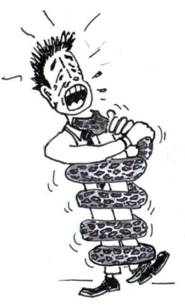If you want to take the snake head-on, start with its tail!
The situation continuously deteriorates, but what should we do?
Through the years I more than once spoke to directors who threw their arms up in the air in despair because they, and their shareholders or Supervisory Board members, could see from the financial reporting that the companies situation, or one of its sub processes, was constantly deteriorating but were not able to turn this around.
Although financial reports are often very well suited to judge the healthiness of your company (or sub process) and may provide a timely signal that action is required, it is normally not well suited to find out what should be done, presenting you any solution.
Similar to a fire detector that is good to detect fire, but isn’t too helpful with finding the cause nor the solution to extinguish the fire, you need some other analytic instrument next to the financial reporting that can lead you to concrete solutions.
Wisdom from the jungle
As a person is being strangled by a snake, the snake fixes its teeth into the victim and revolves its body around it to start strangling. Intuitively both the victim and the people around him start with all their might in shear panic pulling at the head of the snake. However more experienced people know that due to the strength of the teeth and jaws of a Boa, Python or Anaconda, this is a hopeless effort. The only change to escape is when they start disentangling the other way around, start at the weaker tail and work their way up towards the strong head. As we reach the head from that site the snake is helpless and might let loose.

However, if you are unfamiliar with this wisdom from the jungle and unexpectedly attacked by such a snake, it makes perfect sense that you start at the head. If you then see the local Africans or South American Latinos concentrate on the tail a few yards away everything in you yells: “Can we have some focus here!?” Although the head seems the biggest and most profound problem, to escape from this deadly, strangling snake the solution starts at the tail and not at the head.
The analogy with the companies we spoke about earlier is big. Normally when results are disappointing and deteriorating, it makes sense that most of the warning signals, questions and remarks of all involved suggest that the head is most profound problem. However the sequence in what to answer and what solution to implement is often the one that does not make sense or seems straight out counterproductive (‘you really have to start at the tail’).
Problem identification is often abstract and far from the shop floor
Often important problems of companies and other organizations are identified on a high level. High level in the sense of abstraction and the level within the organization. A key customer will complain to a director about the poor service level of the company. The Financial Director signals too little profitability, too much invested capital, too much working capital etc.
Normally all signals and alarm bells are meaningful, but often give too little insight as to what should be done, when and why. This measurement, as is the case with the fire detector, point out that something should be done but not what. Generally the fire detector triggers a top-down process to find the cause of the fire.
Analysis and solutions often in opposite directions
If the profit margins turn out to be too low, just demanding to ‘make more profit’ doesn’t lead to any solution. In order to achieve higher profits, we have to analyze the processes to find out what causes this disappointing margin. This must normally trigger a top-down process of questions, which can lead to identifying a number of factors. This can be illustrated in the following example:-
- There are too little products available for sales orders (turnover too low),
-
because we have got the wrong items on stock (too high working capital).
Why do we have the wrong products on stock? -
Because we are not able to properly plan.
Why can’t we plan properly? -
Because the registration is incorrect (wrong, incomplete, not in time).
Why is the registration not right? -
Because the primary process is not reproducible, we never know how much comes out of the process and therefore how much the material costs.
Why are we not reproducible? -
Because we have a quality issue.
But why do we have a quality issue? -
Because we cannot measure the quality to adjust process parameters.
But why can we not measure the quality? - Because it cannot be measured safely on the shop floor.
Almost all questions asked have a certain ground and do make sense, but a wrong sequence of addressing them and/or wrong timing can become senseless.
In our example it is important to:
- Do something rapidly about the safety situation,y
- to ensure that you are able to measure the quality
- Make the necessary adjustments,so that the process becomes reproducible
- making the registration meaningful (as we may now expect that the production orders will lead to the right quantity, at the right time and use the estimated amount of materials),
- enabling the company to plan the process,
- leading to shorter and more reliable lead times for the required products and less stocks of not needed items,
- reducing the cost price (less scrap) and reducing the capital stuck in working capital (less stocks, shorter lead times).
- which in turn will increases the profitability of the company
In our example problems are felt on different levels and on all these levels something has got to change. Most of the time we see that on all those levels people are in parallel attempting to solve their problem individually. However it is clear that the overall sequence is absolutely not arbitrary and it is obvious what the most effective route is, what and where the priority should be. After all we can train planners, but there is little to plan if the quality, the reproducibility and the registration is incorrect.
Priorities are often set by seniority, rank or preference
The necessary sequence of solutions seldom correspond with the intensity of how the problems are experienced. One can imagine that the CEO (Chief Executive Officer) and the Financial Director (CFO) experience that the financial reporting is not accurate and up to speed enough and they want full focus on that. Whereas in the view of the boss of all Operations (COO, Chief Operational Officer) the biggest flaw is the lack of planning and he want to start there, whereby the production leader and his guys are focused on safety, quality and reproducibility.
The solution to all problems mentioned should be found on a lower level, but the priorities are surprisingly and worryingly frequently decided by the position or the influence of the problem owner(s). The priority often goes to improvement of the financial information. In many cases this choice leads to an immense increase of spreadsheets and shadow system that should be manually fed, and for what in many cases extra staff is needed in the finance department, to feed, maintain and report. Labor intensive work-arounds, shadow files and ledgers introduced in parallel seem to solve everyone’s problems in the short term, but often introduces systems that are difficult and cumbersome to maintain, are not connected and may be or become even contradictory to the main business system. Whilst the profitability was the driver, and already under pressure, this now results in the increase of the overheads.

The analogy with the strangling snake is now becoming eminent. The closer you are to the head, the bigger the problem seems and the bigger the demand to intervene there, while starting at the tail is much more effective and sometimes even the only way to solve the problems. Often the best sequence to solve our problem(s) is opposite to what we think at first and to the urgency we see.
In practice this wrong choosing is often caused by the lack of overview and not being able to see the connectivity and interrelationships. Next to that, it is common to mankind that people that have specific experience and knowhow on a limited domain, terrain or aspect are most likely to identify necessary developments in line with their affinity and expertise. A logistics guy sees too much stock everywhere, a production guy too small batch sizes, the financially oriented person the lack of control, checks and balances and the automation fellow the absence of systems and software.
If one cannot see the intrinsic relationships between problems and solutions, it is quite understandable that many choices are in fact determined by the position and influence of the separate decision makers. In some cases, it is decided to spread the resources evenly amongst everyone and allow them all a part of their desired solution. In this case the coherency is totally gone and disappointment is guaranteed.
First determine the intrinsic relationship between problems and solutions
Before debating and prioritizing it is important to determine whether there are any intrinsic relationships between problems and solutions. These relationships often surpass the specific knowledge and experience of the individual decision makers, as an example in many cases the root cause of an incorrect financial system or general ledger (the problem of the CFO) is an incorrect product structure, Bill of Materials and routing (both the domain of Operations). For that reason it is important to find a person that can oversee the different hemispheres, who can first present and explain the interrelationships, creating a basis for better decision making.
Veghel, augustus 2016




